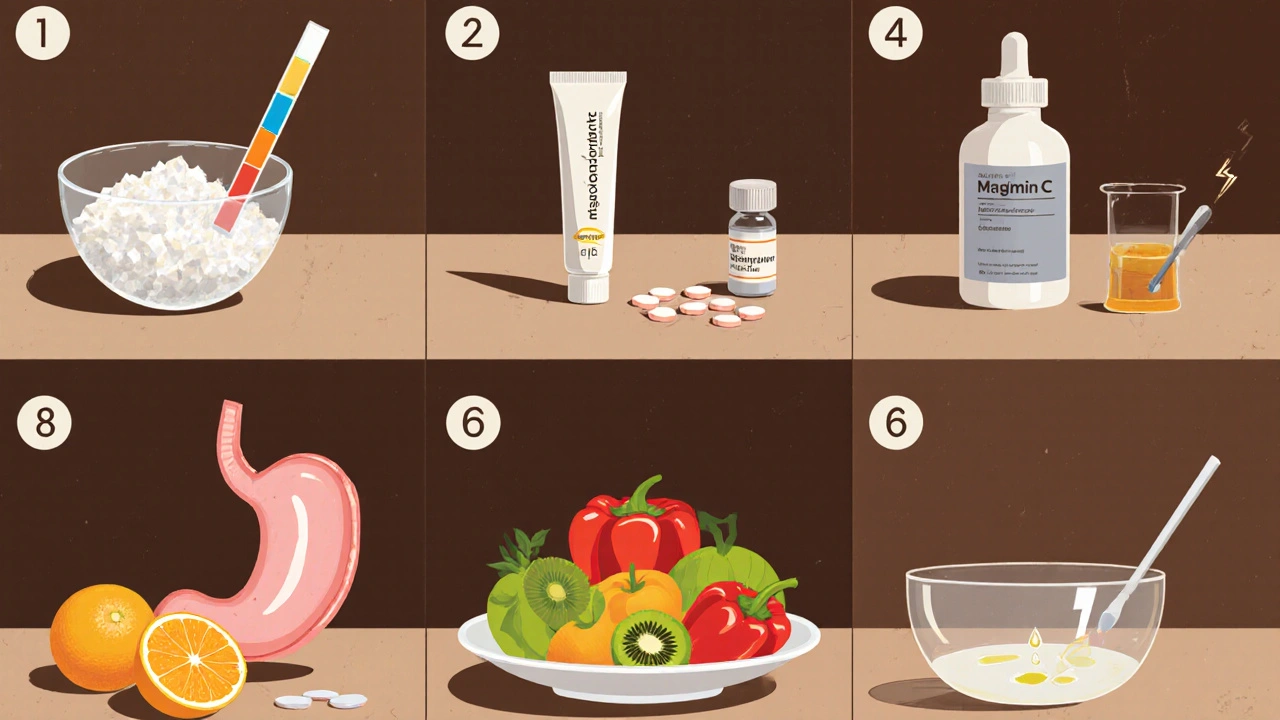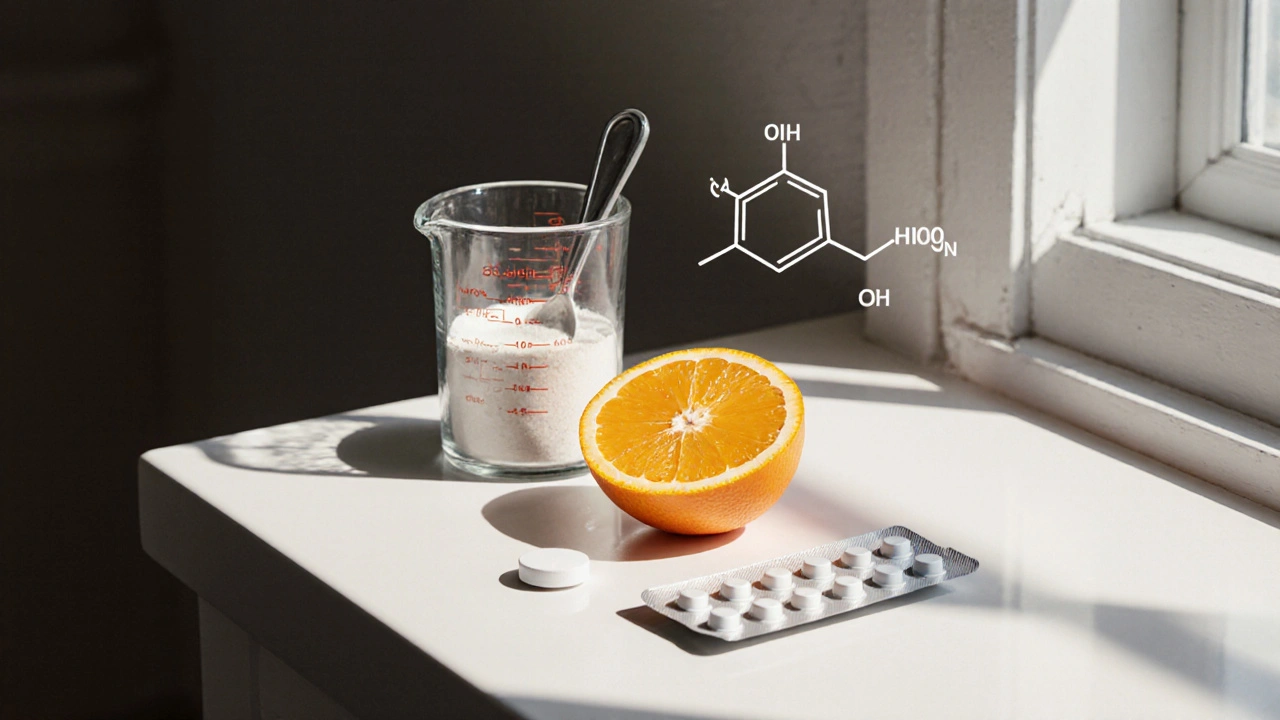Vitamin C Form Selector
Find Your Perfect Vitamin C Form
Answer a few questions to get personalized recommendations based on the article's comparison of vitamin C forms.
Answer the questions above to see your personalized recommendation.
When you hear "Vitamin C", most people picture a citrus fruit or a cheap tablet on the pharmacy shelf. Ascorbic Acid is a synthetic, water‑soluble form of vitamin C that’s been the go‑to supplement for decades because it’s cheap, stable, and widely studied.
Why Compare? The Real‑World Question
Not everyone tolerates plain ascorbic acid well. Some experience stomach upset, while others wonder if a buffered version or a natural source might work better. The goal of this guide is to answer three jobs you probably have after clicking the title:
- Identify the most common alternatives to ascorbic acid.
- Understand how each alternative differs in absorption, side‑effects, and price.
- Pick the right form for your health goal-immune boost, skin support, or athletic recovery.
Core Alternatives at a Glance
Below are the six alternatives we’ll compare against ascorbic acid. Each one appears in the table later, but here’s a quick snapshot.
- Sodium Ascorbate - a buffered, less‑acidic salt.
- Calcium Ascorbate - another buffered form that adds calcium.
- Magnesium Ascorbate - combines vitaminC with magnesium.
- Ascorbyl Palmitate - a fat‑soluble derivative used in cosmetics.
- Natural VitaminC Sources - whole foods like oranges, kiwi, and bell peppers.
- Erythorbic Acid - a synthetic analogue with virtually no vitamin activity, sometimes used as a preservative.
Comparison Table
| Form | Bioavailability | pH (in solution) | GI tolerance | Typical dose (mg) | Best use case |
|---|---|---|---|---|---|
| Ascorbic Acid | ~100% | 1.0-2.0 (strongly acidic) | Low - can irritate stomach | 500-2000 | General immune support, cost‑sensitive users |
| Sodium Ascorbate | ~95% | 7.0-8.5 (near neutral) | High - gentle on stomach | 500-1500 | Those with acid reflux or sensitive GI |
| Calcium Ascorbate | ~90% | 7.0-8.0 | High | 500-1500 | People needing extra calcium |
| Magnesium Ascorbate | ~85% | 6.5-7.5 | Moderate | 500-1200 | Joint health, magnesium deficiency |
| Ascorbyl Palmitate | ~70% (fat‑soluble) | 5.0-6.0 (mildly acidic) | Very high - used in topical creams | 10-100 (as cream) | Skin brightening, anti‑aging creams |
| Natural Food Sources | ~80% (varies by food) | 3.5-5.5 (depends on fruit) | Very high - whole‑food matrix | Varies - 50mg per orange | Daily nutrition, antioxidant synergy |
| Erythorbic Acid | ~0% (no vitamin activity) | 7.0-8.0 | High | N/A | Food preservative, not a supplement |

How Bioavailability Works
Bioavailability is the proportion of a nutrient that actually reaches your bloodstream. For vitaminC, the body uses a sodium‑dependent transporter (SVCT1) that works best at neutral pH. That’s why buffered salts like sodium or calcium ascorbate often feel easier on the stomach yet still get absorbed efficiently.
Fat‑soluble forms such as ascorbyl palmitate hitch a ride on dietary fats. They’re great for skin creams because the fatty chain helps the molecule dissolve into the outer layers of the epidermis, but oral absorption is lower than the plain acid.
Whole‑food sources bring along bioflavonoids-natural compounds that protect vitaminC from oxidation and may even boost its uptake. Studies from 2022‑2024 show a 10‑15% increase in plasma vitaminC when you eat an orange versus taking a pure ascorbic‑acid tablet of the same milligram amount.
Side‑Effect Profile: What to Watch For
Plain ascorbic acid can cause:
- Heartburn or acid reflux (especially >2g per day).
- Loose stools or diarrhea if you exceed the gut’s absorptive capacity.
- Kidney‑stone risk in susceptible individuals (oxalate formation).
Buffered salts generally eliminate the heartburn issue because they raise the solution’s pH. Calcium ascorbate adds a modest calcium boost, which can be a plus for bone health but may cause constipation in large doses.
Magnesium ascorbate may give you a mild laxative effect-useful if you’re constipated, but not ideal if you already have loose stools.
Ascorbyl palmitate, when taken orally in high doses, can lead to fat‑soluble vitamin toxicity (unlikely at normal supplement levels). Topical use is safe for most skin types, but people with very oily skin sometimes report a greasy feel.
Natural sources rarely cause side effects, but excessive citrus can irritate enamel and aggravate GERD.
Cost Considerations
Price is a practical factor. In the UK market (2025 data):
- Bulk ascorbic‑acid powder: ~£5 for 500g (≈100g of pure vitaminC).
- Sodium ascorbate tablets: £8-£12 for 500mg × 100 tablets.
- Calcium ascorbate: £10-£14 for 500mg × 100 tablets.
- Magnesium ascorbate: £12-£16 for 400mg × 90 tablets.
- Ascorbyl‑palmitate cream: £15-£25 for 30ml.
- Organic orange juice (as a vitaminC source): £2 per litre (≈50mg per 100ml).
If you’re on a tight budget, plain ascorbic acid wins hands‑down. If stomach comfort is worth a few extra pounds, sodium or calcium ascorbate are worth the spend.

Choosing the Right Form for Specific Goals
Immune support during a cold season - Any form works, but a buffered salt reduces the chance of acid‑related heartburn, so sodium ascorbate is a safe bet.
Skin brightening or anti‑aging - Look for topical products containing ascorbyl palmitate or magnesium ascorbyl phosphate (a similar stable form). They penetrate the skin better than water‑soluble acid.
Bone health alongside vitaminD - Calcium ascorbate adds a modest calcium dose without the need for a separate supplement.
Joint or muscle recovery for athletes - Magnesium ascorbate supplies both vitaminC and magnesium, which helps with muscle relaxation and reduces cramping.
Everyday nutrition with the least processing - Whole‑food sources (citrus, kiwi, strawberries, red peppers) give you vitaminC plus bioflavonoids, fiber, and other phytonutrients.
Practical Tips for Maximising VitaminC Intake
- Split your dose. The intestines absorb about 200mg at a time; taking 500mg twice a day improves overall uptake.
- Take with food. Fat‑soluble forms like ascorbyl palmitate need a small amount of dietary fat to get absorbed.
- Store powders dry and cool. VitaminC oxidises quickly when exposed to heat, light, or moisture.
- Pair with iron‑rich foods. VitaminC dramatically boosts non‑heme iron absorption-great if you’re vegetarian.
- Watch for interactions. High‑dose vitaminC can increase the metabolism of certain drugs (e.g., oral contraceptives).
Bottom Line Summary
Plain ascorbic acid remains the most affordable and widely researched form of vitaminC, but it can irritate the stomach at higher doses. Buffered salts-sodium, calcium, and magnesium ascorbate-offer similar bioavailability with better GI comfort and added mineral benefits. Ascorbyl palmitate is a niche choice for skin‑care products, while natural food sources give you extra phytonutrients and the best overall tolerance. Your ideal pick depends on budget, digestive sensitivity, and the health goal you’re targeting.
Frequently Asked Questions
Is ascorbic acid the same as vitaminC?
Yes. Ascorbic acid is the chemical name for the synthetic form of vitaminC that most supplements contain.
Can I take both ascorbic acid and sodium ascorbate together?
You can, but it’s usually unnecessary. Combining them doesn’t boost absorption and just adds extra sodium or acid.
Which form is best for people with acid reflux?
Buffered salts like sodium ascorbate or calcium ascorbate are gentler because they raise the pH of the solution, reducing heartburn risk.
Does cooking destroy vitaminC in foods?
Heat, water, and air all degrade vitaminC. Lightly steaming vegetables or eating raw fruit preserves the most vitaminC.
Can high doses of vitaminC cause kidney stones?
In susceptible individuals, large amounts (≥2g per day) can increase oxalate excretion, which may contribute to calcium‑oxalate stones. Split dosing or choosing a buffered form helps mitigate the risk.

Georgia Kille
October 13, 2025 AT 19:13Great overview-especially the gut‑friendly tip about splitting doses! 😊
Jeremy Schopper
October 13, 2025 AT 20:03Thank you for the thorough analysis; the distinction between buffered salts and pure ascorbic acid is crucial, particularly for individuals with reflux; the inclusion of cost data for the UK market adds valuable context, and the practical dosing advice aligns well with clinical recommendations.
liza kemala dewi
October 13, 2025 AT 20:53When one contemplates the myriad forms of vitamin C, the dialogue inevitably transcends mere biochemistry and enters the realm of epistemological inquiry. The ancient alchemists might have marveled at the transformation of a simple molecule into a cornerstone of human health. Contemporary science, however, demands rigorous quantification, yet we must not forsake the philosophical awe that accompanies each discovery. As we compare ascorbic acid to its buffered counterparts, we are reminded that the human body is an intricate tapestry of pH balances, enzymatic pathways, and cellular symphonies. The assertion that sodium ascorbate mitigates gastric irritation is not merely a pharmacological fact; it is an invitation to consider how our modern diets have altered the gastric milieu. Moreover, the inclusion of calcium ascorbate introduces a dual narrative of bone health and antioxidant defense, prompting reflection on the interconnectedness of mineral homeostasis and oxidative stress. The discussion of magnesium ascorbate, in turn, raises questions about the synergy between muscular relaxation and free‑radical scavenging, an elegant illustration of the principle that nutrients seldom act in isolation. While the table delineates bioavailability percentages, one might argue that the lived experience of patients-subjective tolerability, perceived energy, and even the psychological comfort of ‘natural’ sources-constitutes an equally valuable metric. The article rightly highlights the cost differential, prompting a socioeconomic analysis: does the incremental expense of buffered salts justify the marginal benefit for a population segment with acid‑sensitivity? In the context of public health, accessibility remains paramount, and the author’s acknowledgement of plain ascorbic acid’s affordability underscores a democratic approach to supplementation. Yet, the recommendation to pair vitamin C with iron‑rich foods invites a broader conversation about nutrient interactions and the holistic nature of dietary patterns. The practical tips-splitting doses, storing powders properly, and pairing with dietary fat-serve not only as actionable guidance but also as a reminder that optimal nutrient utilization is a dynamic process, contingent upon timing and context. One cannot ignore the cautionary note regarding oxalate formation and kidney stone risk; here, the balance between therapeutic dose and potential adverse effect resurfaces, echoing the age‑old principle of ‘primum non nocere.’ Finally, the emphasis on whole‑food sources aligns with a growing body of literature that valorizes food matrices over isolated compounds, suggesting that the synergy of bioflavonoids, fiber, and micronutrients may amplify the antioxidant capacity beyond that of synthetically derived pills. In sum, this comparative treatise does more than enumerate forms; it weaves a narrative that bridges molecular science, clinical pragmatism, and philosophical reflection, inviting readers to contemplate not just which form of vitamin C to choose, but why that choice matters within the broader tapestry of health and well‑being.
Jay Jonas
October 13, 2025 AT 21:43Wow, this guide really nailed it! The way you broke down the stomach‑friendly options is sooo helpful – especially for us who gots the occasional heartburn. I love the bit about natural foods too; it’s like, why pay for pills when you can just eat an orange, right? The dramatic flair in the comparison table made the data pop – good job!
Liam Warren
October 13, 2025 AT 22:33From a bioavailability standpoint, the kinetic parameters of ascorbic acid versus its buffered salts can be modeled using Michaelis‑Menten dynamics, where the Vmax is effectively modulated by the pH‑dependent transporter affinity. In clinical nutrition parlance, we refer to this as the ‘absorption ceiling’ – essentially the point beyond which incremental dosing yields diminishing plasma concentrations. The article’s practical recommendation to split doses aligns with this kinetic ceiling, maximizing the area under the curve (AUC) while minimizing GI upset. Moreover, the inclusion of mineral co‑factors-calcium and magnesium-introduces a synergistic effect on bone remodeling pathways via osteoblast activation, a nuance often overlooked in mainstream supplementation guides. When we consider the systemic antioxidant capacity, the total reductive potential (TRP) is enhanced by concurrent bioflavonoid intake, a factor that whole‑food sources inherently provide.
Brian Koehler
October 13, 2025 AT 23:23Excellent work on dissecting the cost vs. benefit landscape!; The clear breakdown of UK pricing provides actionable intel for budget‑conscious consumers; It’s refreshing to see a guide that doesn’t just glorify the cheapest option but also respects the physiological realities of acid‑sensitive individuals; Keep the data‑driven approach coming!
Dominique Lemieux
October 14, 2025 AT 00:13While the author presents a polished overview, one could argue that the emphasis on buffered salts subtly nudges readers toward more expensive, market‑driven products, perhaps at the expense of truly evidence‑based minimalism. The omission of longitudinal studies comparing renal outcomes across different vitamin C salts feels like a deliberate gap, leaving the inquisitive mind yearning for deeper insight. Moreover, the claim that magnesium ascorbate aids joint health, though superficially plausible, skirts the nuanced interplay between collagen synthesis and oxidative stress-areas where the literature remains equivocal at best. The table’s bioavailability percentages, presented as definitive figures, ignore the inter‑individual variability driven by gut microbiome composition, transporter polymorphisms, and even circadian rhythm influences on nutrient absorption. In short, the guide serves as a well‑packaged entry point, yet it stops short of challenging the status quo or prompting the critical reader to interrogate the underlying assumptions that dictate commercial supplement formulations.
Laura MacEachern
October 14, 2025 AT 01:03Such a friendly and thorough guide! I really appreciate the balanced take on both cost and comfort – it makes choosing the right vitamin C feel less overwhelming. Keep spreading the positivity!
BJ Anderson
October 14, 2025 AT 01:53While the article is comprehensive, it glosses over the potential for high‑dose vitamin C to exacerbate oxalate burden in susceptible individuals. This oversight could mislead readers into a false sense of security.
Alexander Rodriguez
October 14, 2025 AT 02:43The guide is solid, but the use of technical jargon could be toned down for a broader audience.
Abhinav Sharma
October 14, 2025 AT 03:33👍 Great job! The emoji‑friendly tone makes the science approachable, and the clear dosing split advice is spot‑on. 🌟
Welcher Saltsman
October 14, 2025 AT 04:23Loved the practical tips, especially the food combo advice. Keep it simple and useful.
april wang
October 14, 2025 AT 05:13Reading through this guide felt like embarking on an enlightening journey through the intricate landscape of vitamin C chemistry, physiological impact, and pragmatic lifestyle integration. The author's methodical breakdown of each form's bioavailability, gastric tolerance, and ancillary mineral benefits not only arms the reader with actionable knowledge but also underscores the importance of personalized nutrition strategies. By juxtaposing cost considerations with therapeutic efficacy, the piece respects the diverse economic realities of its audience while steadfastly advocating for evidence‑based selections. The concluding emphasis on whole‑food sources serves as a gentle reminder that, despite the allure of synthetic convenience, nature's own offerings often provide synergistic compounds-bioflavonoids, fibers, and phytonutrients-that amplify the antioxidant capacity of vitamin C beyond what isolated compounds can achieve. Overall, this comprehensive synthesis empowers individuals to make informed decisions tailored to their unique health goals, digestive sensitivities, and budgetary constraints.
Vishnu Raghunath
October 14, 2025 AT 06:03Oh great, another article telling us the “best” vitamin C-like we needed more corporate hype. Maybe next time they'll remind us to avoid the fluoridated water while we're at it.
Aparna Dheep
October 14, 2025 AT 06:53Honestly, the piece feels a bit pedestrian-more depth on enzymatic pathways would elevate it from the realm of superficial health blogging to scholarly discourse.